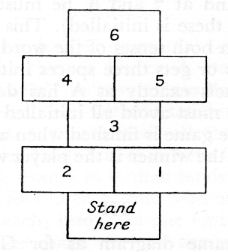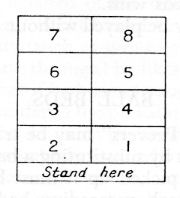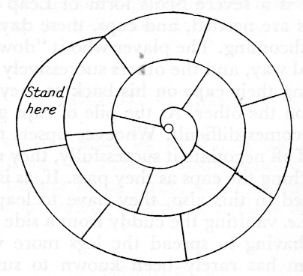|
Peever is so peculiarly a
Scottish game that the English call it Hopscotch. It is also sometimes
known as Beds. But Peever is still the proper, as it is the old name. It
is essentially a pavement game, as the lines between flagstones create
natural "beds", and a hard smooth surface is best for the "scliffing" of
the peever or pierre, which, along with a piece of chalk, is all the
apparatus required. It can, however, be played in a large room or on hard
earth, the beds on earth being scored in. The different sizes of paving
stones may be utilised by players to create a stimulating unevenness which
demands the utmost skill and judgment in hopping. But beginners or male
players had better content themselves with regular beds. Those who regard
the pastime as feminine-i.e. effeminate-had better try it first before
expressing this opinion aloud. They will probably go back to its table
variant, Shove-halfpenny, which is not only less strenuous but has the
advantage over Peever in always being played to an accompaniment of beer.
The peever (pierre)
is a roughly rounded flat disc of marble, stone or pipe-clay about 2
inches in diameter and I of an inch thick. A piece of tile will serve.
I
A diagram is marked out
thus:

Order of play is decided by
mutual agreement, fight or counting-out rhyme. Player A stands in space
marked and "scliffs" the peever into Bed 1. If it does not come to rest in
bed without touching a line, this is a "loss" and A retires until all the
others have played. If peever lands fairly, A hops from Stand to 2 with
one hop, from 2 to 3, then lands with one hop into 4 and 5, a foot in
each; into 6 on one foot; 7 and 8, one foot in each; into 9 on one foot.
Player turns round and comes down the row similarly.
II
A stops on one foot in Bed
2, picks up peever from Bed 1, hops into 1, thence into Stand. To fall,
touch line with foot, land twice in one space, or indeed to infringe any
rule of procedure constitutes a "loss" and retirement. If A has got
through this ordeal successfully, he scliffs the peever into Bed 2, hops
into I, over row 2 into 3, and then continues as before. After that he
does his "Threesie Up", "Foursie Up", etc., to 9, which he does twice,
then returns down the line - "Eightsie Down", etc. If he gets through
these 18 rounds successfully he marks his initials on any space he
chooses. This space must not be trespassed on by any player thereafter. It
is definitely forbidden ground. A is rewarded for success by another turn.
This time instead of hopping he jumps with both feet simultaneously. Of
course, he has to do 4 and 5, 7 and 8 successively, instead of together as
before. He does the "up and down" series. Note that there will be only 16
rounds this time, since a bed is initialled. He may be a "loss" at any
time during this part of the game, but his initials remain; that is his
point for the whole game. If he has succeeded in the jumping round, he has
to walk the beds with eyes shut, taking one step and one step only to each
bed and missing initialled beds. At 4 and 5 and at 7 and 8, he must come
astride (unless one of these is initialled). This round finishes A,
generally in both senses of the word. As soon as A has had a loss or gets
three spaces initialled, B commences and acts exactly as A has done,
except of course that he must avoid all initialled beds from the
beginning. The game is finished when all the beds are initialled, and the
winner is the player with most beds to his credit.
III
Draw the same diagram as
for Game A. First player from Stand scliffs the peever into Bed 1, hops up
to it on right foot, then with a tap with the side of the right foot
knocks it into Bed 2. He approaches it again by hops (as many as he likes,
but never landing on a line) and knocks it as before into Bed 3, then into
4, 5, 6, 7, 8, 9, 9, 8, . . . 1, Stand. Thus "Onesy Right" is completed.
Now begins "Onesy Left", which is the same programme, but hopping on the
left foot and kicking with it. If he has not made a loss, he scliffs
peever into Bed 2 and does his "Twosy Right", then "Twosy Left" and so on.
If he gets right through his ordeal, finishing at "Ninesy Left", he has to
go through the whole process once more, but allowing himself only one hop
from bed to bed. This should kill him off; but, should he survive, he does
the business once more with eyes shut and taking any number of hops to
each bed but knocking the peever into the appropriate bed with one kick.
It is unlikely that any player will finish the course. Next player begins,
and whoever has gone furthest in the sequence is, of course, winner.
IV
Discouraged or less ambitious players may
use this diagram:

V
Another less ornate fashion of the game is
played with this diagram:

VI
Draw on the ground the
following diagram:

Player A from the Stand
scliffs the peever into the first bed, approaches it by one hop, kicks it
with the side of the hopping-foot into second bed, approaches it by one
hop again and knocks it into third bed, and so on till he reaches the
centre. He then initials any one bed, and on his next round is entitled to
rest as he pleases in that bed. This continues till he makes a "loss".
Player B has to repeat A's performance, but he has to skip A's initialled
beds, i.e. he must scliff the peever straight into the following bed and
hop into it right over A's initialled bed. Game continues until every
player in succession makes a loss. Player with most initialled beds wins.
This game may be played
without a peever, players merely hopping.
BALL BEDS
Any game of "Peevers" may
be transformed into a game of Ball Beds by substituting a ball for the
peever. After the ball is picked up it must be bounced once and caught in
each succeeding bed.
BUNNETY
Bunnety is a severe Scots
form of Leap Frog, for which caps are needed, and caps, these days, are
not always forthcoming. The player who is "down" stoops in the usual way,
and the others successively leap over him, placing their caps on his back
as they go, each cap piled on the other. As the pile of caps grows, the
placing becomes difficult. Whoever upsets the pile is "down". If all
negotiate it successfully, they repeat the jump, touching the caps as they
pass. If, as is unlikely, they succeed in this also, they have to leap the
pile sideways, i.e. vaulting the cuddy from a side approach and thus
having to spread the legs more widely. A whole team has rarely been known
to survive this round, but should they do so, the next test is to leap
from the side approach but without touching back or caps. Some boys can do
this.
WRANG SOO BY THE LUG
A player stands with his
hands clasped behind his head, fingers interlocked. The others stand
behind him. One of them hits him a smack on the hands with his open palm
and he wheels round as quickly as he can and tries to spot the player who
smacked him. This gives all the players an opportunity for acting. The one
who is accused of the smack challenges his accuser by saying, "What have I
to do?" The accuser orders any penalty (such as standing on his hands and
smoking a cigarette through) he likes, but he does so in the knowledge
that if he has not caught the right man he must himself undergo the
punishment he prescribes. In addition to this he must go on in his
original role till he catches somebody out, who takes his punishment and
his place. Of course, instead of a smack, players can touch gently.
Anything is allowed that aids deception and puts the standing member on
the wrong tack.
[N.B.-The same game can be
played with caps tied on to strings, the caps being used instead of hands
for touching or walloping. It is then called Bu the Bear.] |

